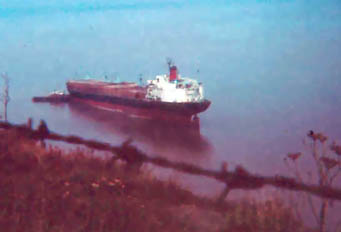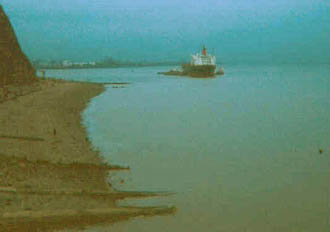New Westminster City (4)
Comments from the forum - 1
Grounding of the New Westminster City off Cardiff November 1972.
At the time this happened I heard about it on Radio Wales, and as I do not live far from Penarth I went to have a look and took these photos.
However either in the Western Mail or the South Wales Echo or may even both a photographer had walk out to her when she was high and dry, his photo showed the aft part of the stern frame several feet above the rocks and the ship sat down by the head at an alarming angle, my photo's where taken when the next tide was on its way in and I suspect starting to give her some support up fwd.
I have tried this year to see if I could get that photo from the Western Mail without any luck, If anybody does get a copy its a frightening shot for everyone involved. (Has anybody got a copy?)
If you go to Cardiff now you can walk out to almost where this happened on the new Cardiff bay barrage. Willie Davis. Posted on Forum 11th December 2009.
 |
 |
| Click here for photos of the repair. Both photographs above Copywrite © Willie Davies | |
All of us of a certain age will remember the New Westminster going ashore in the approaches to Cardiff and almost in front of the RSL offices in 1972. It was poor Joe Thornhill's last voyage as Master, not that the grounding was his fault.
I was due to join her the day after the NWC ran aground off Cardiff as 2/0, but eventually joined her in Antwerp,( with John Cann as Master) after discharge of the cargo and just before we put her into drydock in Amsterdam. As I understand it, the story of her grounding is that in fog approaching Cardiff docks, under pilotage as you say, she strayed just too far to port of the channel, which at that time was only marked by starboard hand buoys. She was very lucky not to break her back on the large falling tide and it was surmised that it was only the weight of the timber deck cargo which prevented her breaking in two, combined with strength of the transverse bulkhead. When we went into drydock and inspected the bottom her keel was bent some 10 inches or so so just below the bulkhead of 4/5 hatch. They had to carry out extensive steel renewals in the dock to effect the repairs. Apart from that, she was a good ship to serve on. All of us of a certain age will remember the New Westminster (the bulkie) going ashore in the approaches to Cardiff and almost in front of the RSL offices in 1972/73. Here is my previous response to a photo posted by Willie Davis showing her right under the cliffs.
I was due to join her the day after the NWC ran aground off Cardiff as 2/0, but eventually joined her in Antwerp,( with John Cann as Master) after discharge of the cargo and just before we put her into drydock in Rotterdam. As I understand it, the story of her grounding is that in fog approaching Cardiff docks, under pilotage as you say, she strayed just too far to port of the channel, which at that time was only marked by starboard hand buoys. She was very lucky not to break her back on the large falling tide and it was surmised that it was only the weight of the timber deck cargo which prevented her breaking in two, combined with strength of the transverse bulkhead. When we went into drydock and inspected the bottom her keel was bent some 10 inches or so so just below the bulkhead of 4/5 hatch. They had to cut her in two in the dock to effect the repairs. Apart from that, she was a good ship to serve on. Graham Mapplebeck. Posted on Forum 11th December 2009.
I was due to join the NWC in Cardiff the day after this happened, however after it happened I got called into see Graham Hardy, he told me RSL was down by the head with B&W men, what the company really needed was Sulzer men so off to the Wilkawa I went. Mind you some time later I asked Mr Hardy could I have a change from the west coast of Mexico on the Maria Elisa and Sara Lupe, he agreed & put me on the Gela and the east coast of Mexico
In 1976 I did get to sail on the NWC and I was aware she had had extensive repairs done to her, but what I never understood was no matter how far down by the stern she was the bilges in the engine room always ran to the forward bilge, I only sailed on one other 840 the Vancouver city and she did not do that.
Willie Davis. Posted on Forum 11th December 2009.
I sailed aboard the NWC on three occasions, post Penarth grounding, once as Mate and twice as Master. Although I have mostly happy memories of those voyages, sadly, I fear, she never really recovered after the incident. In particular, though not uncommon in some of the other 840's, she developed a particularly bad weak spot below the forward bulkhead of No.3 hold. This resulted in fracturing at the top of the bulkhead that lead to leakage, sometimes heavy, of ballast water from No 3 into No 2 hold.
I recall one particular ballast passage, which Graham will also remember, when the leak became so bad that it was necessary to remove, with difficulty, the covers to the after end No 2 hopper tanks in order to continuously pump out No 2 Hold for the duration of that passage. The matter was compounded by the fact that the ballast pump was out of action, and necessitated a constant watch of the situation by both and deck and engine room officers. Graham, I am sure, remembers specifically, that on occasions, this entailed us donning swimming trunks, and swimming the length of the hold. He and I share some mutual thoughts on the subject, but I shall not be controversial!!
Though the situation never arose so badly on my other voyages aboard her, the problem still remained. Mike Jones. Posted on Forum 12th December 2009.
Disclaimer: The statements on this page are the views of the person who posted them on the forum. The events took place many years ago and in most cases rely on those people's memories, and so we cannot guarantee the accuracy although every effort is made to check it.
New Westminster City. Page [1] [2] [3] [4] [5] [6]
Memories from RSL staff. [1] [2]

